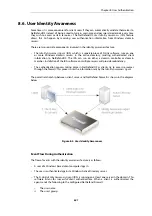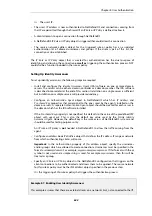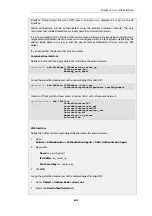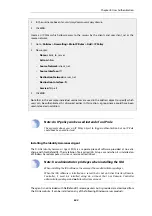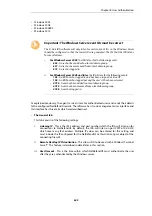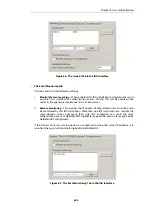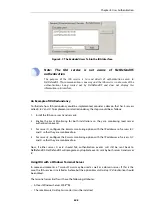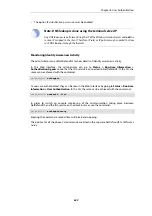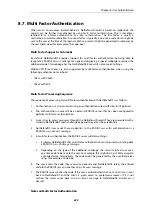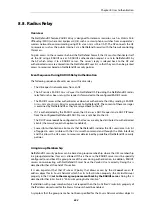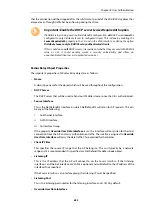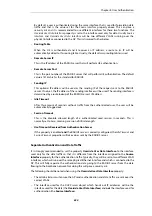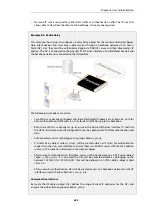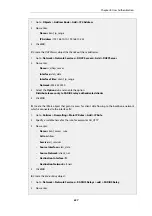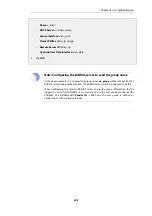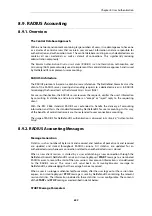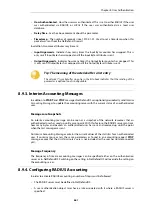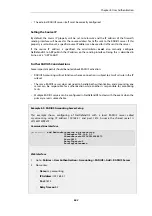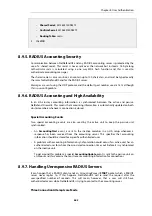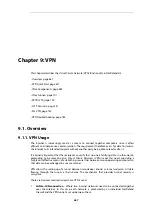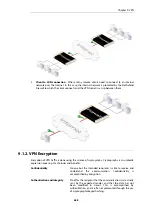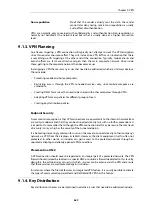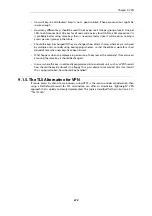
•
No extra IP rule is required for either DNS traffic or authentication traffic. The IP rule that
allows data to flow from the client to the backbone is the only one required.
Example 8.8. Radius Relay
This example shows how to configure a
Radius Relay
object for the scenario illustrated below.
Here, client devices (UE) must access data services through a backbone network via an Access
Point (AP). First, they must be authenticated against a RADIUS server and then allocated an IP
address. The AP is connected to the physical
If1
Ethernet interface of a NetDefend Firewall and
the backbone network is connected to the
If2
interface.
The following assumptions are made:
•
Two VLANs are already configured and these NetDefendOS objects are called
vlan_auth
for
client authentication traffic and
vlan_data
for data traffic flowing to the backbone.
•
Both these VLANs are already set up to run over the physical Ethernet interface
If1
and that
the AP has also been correctly configured to use the appropriate VLAN for authentication and
data.
•
Authenticated users must belong to the group called
ue_group
.
•
A
Radius Relay
object called
r_relay1
will be created which will listen for authentication
requests on the
vlan_auth
interface and relay them to a RADIUS server with the IPv4 address
radius_ip
. The scenario is illustrated in the diagram below.
•
After successful authentication, IP address leases will be handed out by a DHCP server object
called
rr_dhcp_server
. It is assumed the UEs will be allocated addresses belonging to the
network
192.168.10.10-192.168.10.255
that will be defined in an IPv4 address object called
client_net
.
•
After successful authentication, UEs will be granted access to a backbone network on the
If2
interface using an IP rule called
client_access_rule
.
Command-Line Interface
A. Create the
IP4Address
object that defines the range of client IP addresses for the UEs and
assign it the authentication group called
ue_group
:
Chapter 8: User Authentication
655
Содержание NetDefendOS
Страница 30: ...Figure 1 3 Packet Flow Schematic Part III Chapter 1 NetDefendOS Overview 30 ...
Страница 32: ...Chapter 1 NetDefendOS Overview 32 ...
Страница 144: ...Chapter 2 Management and Maintenance 144 ...
Страница 220: ... Enable DHCP passthrough Enable L2 passthrough for non IP protocols 4 Click OK Chapter 3 Fundamentals 220 ...
Страница 267: ... SourceNetwork lannet DestinationInterface any DestinationNetwork all nets 4 Click OK Chapter 3 Fundamentals 267 ...
Страница 284: ...Chapter 3 Fundamentals 284 ...
Страница 360: ...The ospf command options are fully described in the separate NetDefendOS CLI Reference Guide Chapter 4 Routing 360 ...
Страница 392: ...Chapter 4 Routing 392 ...
Страница 396: ...Web Interface 1 Go to Network Ethernet If1 2 Select Enable DHCP 3 Click OK Chapter 5 DHCP Services 396 ...
Страница 419: ... Host 2001 DB8 1 MAC 00 90 12 13 14 15 5 Click OK Chapter 5 DHCP Services 419 ...
Страница 420: ...Chapter 5 DHCP Services 420 ...
Страница 424: ...2 Now enter Name lan_Access Action Expect Interface lan Network lannet 3 Click OK Chapter 6 Security Mechanisms 424 ...
Страница 573: ...Chapter 6 Security Mechanisms 573 ...
Страница 575: ...This section describes and provides examples of configuring NAT and SAT rules Chapter 7 Address Translation 575 ...
Страница 607: ...Chapter 7 Address Translation 607 ...
Страница 666: ...Chapter 8 User Authentication 666 ...
Страница 775: ...Chapter 9 VPN 775 ...
Страница 819: ...Chapter 10 Traffic Management 819 ...
Страница 842: ...Chapter 11 High Availability 842 ...
Страница 866: ...Default Enabled Chapter 13 Advanced Settings 866 ...
Страница 879: ...Chapter 13 Advanced Settings 879 ...

